"A cornucopia of tunings with airy voicings, suspended chords and rich, colorful soundscapes." Learn the alternate tunings and percussive guitar style of indie pioneer Ani DiFranco in our exclusive audio lesson
We've distilled the essential elements of this unique acoustic trailblazer into eight informative examples

Ani DiFranco may not have tried every guitar tuning, but listening to her unique brand of dynamic and percussive folk/punk/rock songs, it can certainly seem that way. What is clear, however, is that she is a genuine trailblazer. DiFranco fearlessly navigated uncharted waters, carving out a successful career as an acoustic guitar playing singer-songwriter without any support from the music industry establishment. This was unheard of in the “before times,” prior to the cultural explosion that is the internet.
Entirely self-made, she is one of the first truly independent or “indie” artists, establishing her very own record label, Righteous Babe Records, in 1990, at only 19 years of age. Since then, she has released 20 studio albums on Righteous Babe, as well as those of over 30 other recording artists who are or have been on the label’s roster. Her most recent release is 2021’s Revolutionary Love, which features a string quartet, among a host of other instruments.
DiFranco considers folk icon Pete Seeger to be one of her primary mentors (he made a guest appearance on her 2012 album ¿Which Side Are You On?), and, like Seeger, she is outspoken politically, championing causes such as LGBTQ and abortion rights. A woman of many talents, in 2023, Ani authored her first children’s book, The Knowing, and, in February of 2024, made her Broadway debut as Persephone in Hadestown, which won multiple Tony awards in 2019, including Best Musical. But at her core, she is at once a unique and original guitarist and a songwriter of great depth. So, for this lesson, we’ll embark on a tuning journey through her songs, carefully curated so as to require as few tuning-peg turns as possible.
Some business first, though, as we’d be remiss not to talk about the guitarist’s unorthodox approach to playing fingerstyle. DiFranco strums or plucks her strings with her fingers, but to achieve her often aggressive style, she applies thick, plastic fingernails, made by Nailene. On occasion, one of her strummed onslaughts will cause one to fly off, so she reinforces them with black electrical tape, down to her second knuckle, to keep them securely in place. In the event that a nail does happen to fly off, it’ll conveniently stick to the tape, allowing her to quickly reapply it. Plus, it protects her skin from the beating it would take from how hard she often strums. (If you have an interest in following Ani's example, check out our informative guide to acrylic nails.)

Despite using all sorts of open and alternate tunings, Ani’s catalog is also chock full of songs in standard tuning, and that’s where we’ll begin. The guitarist began playing in bars and coffee shops in Buffalo, New York at just nine years old, accompanying her guitar teacher and mentor, Michael Meldrum; she quickly learned that it was no easy feat to attract the attention of bar patrons, who were there more to drink than to listen to an unknown folk singer. This led her to develop a powerful and dynamic style, with sudden bursts of volume, as if to say, “Hey! I’m over here!”
A perfect example of this is “Both Hands” from her debut album, Ani DiFranco (1990), which inspired Ex. 1. DiFranco is quite adept at plucking in such a way as to create a smooth and gradual uptick in volume, known as a crescendo. Before attempting the entire example, simply repeat the first bar, with the goal being to seamlessly move from soft (“p” for piano) to loud (“f” for forte) as you swell through the dynamic range. Once you’re ready to tackle the entire progression, the main challenge will be to quickly go from each chord’s final loud pluck — the accent mark indicates to pluck with just a little extra oomph — to immediately playing the next chord softly. Lastly, each chord should be plucked as staccato (short) as possible, by quickly resting your pick-hand fingers on the strings directly after each one is played.

Ani wrestles with her own identity in “In or Out,” from 1992’s Imperfectly. (She came out as bisexual in her 20s.) The song gives us an introduction to the guitarist’s signature aggressive strumming style, where her guitar is again in standard tuning, this time capo-ed at the 2nd fret. Ex. 2 brings the song to mind and employs two of her approaches to creating memorable guitar parts. The guitarist will often move a single chord shape around the neck, adjusting the fingering to stay in key or add colorful notes. These shapes often include a host of jangly open strings, creating a swirling sonic landscape that lends a welcome fullness, especially when playing solo, which the guitarist often does.
All the latest guitar news, interviews, lessons, reviews, deals and more, direct to your inbox!
Keeping your pick-hand relaxed, strum with the tips of your fingers. You need not apply Ani’s aforementioned fake nails, but they do facilitate a more percussive attack. This effect is especially noticeable on beat 2 of each bar; deaden the strings with your fret hand (indicated with X’s), striking them with gusto, and giving the illusion of the sharp attack of a snare drum. DiFranco frequently plays through an amplifier (more on this later), and this effect is made extra impactful by using some reverb. The example ends with some aggressive Ani-style strumming, so hit those accented beats hard! Lastly, note the indicated strum pattern.
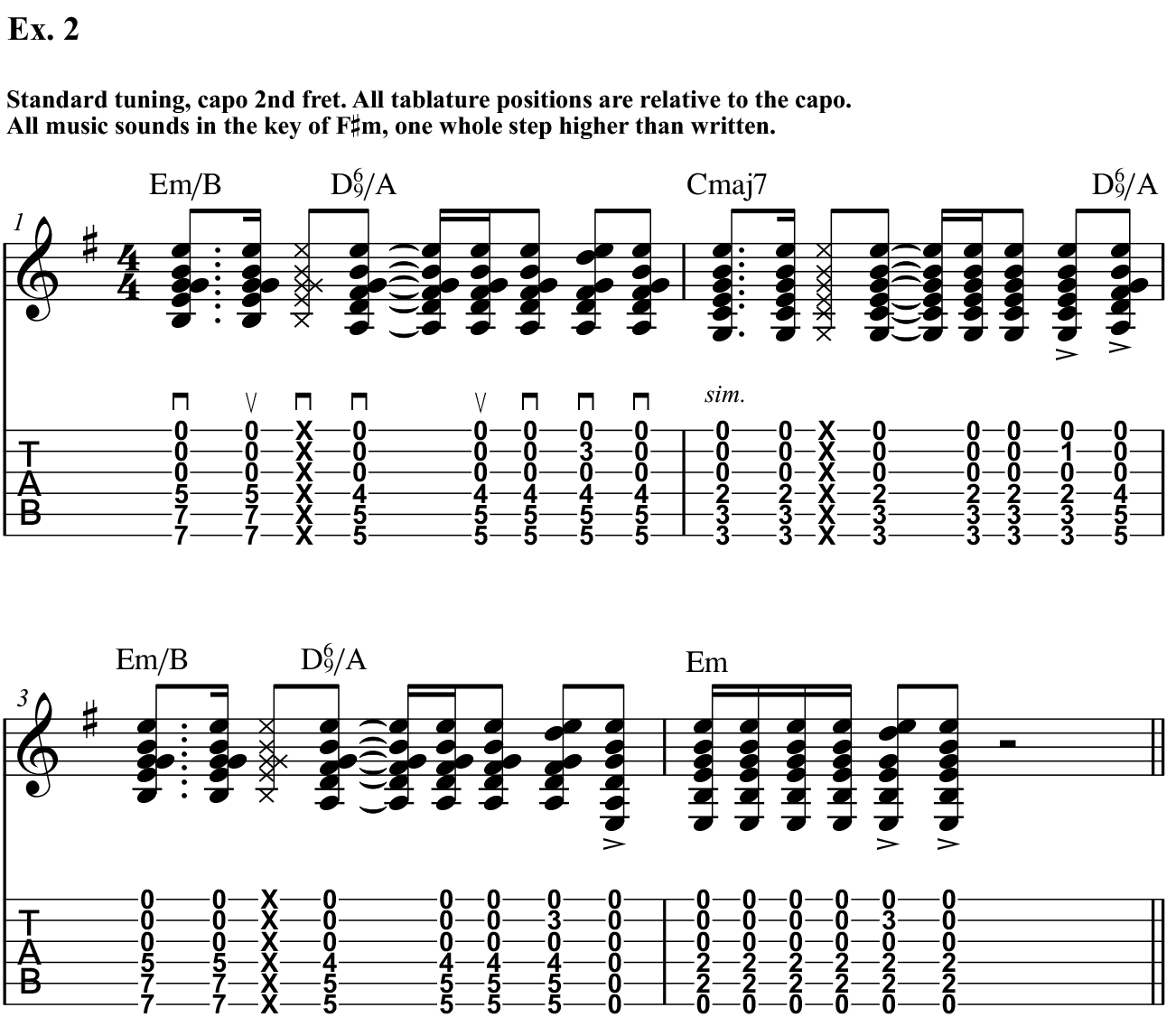
Now that we’ve gotten a feel for the guitarist’s playing style, let’s begin to explore her creativity with tunings. One often thinks of tuning strings down, but tuning them up is also a fine option. (One just has to be mindful of string breakage; if tuning up more than roughly a whole step, lighter gauge strings are recommended.) For the title track to 1995’s Not a Pretty Girl, DiFranco does both, tuning her 5th string up to B, her 4th string down to that very same pitch and her 1st string down to D, resulting in what could be called “open Em7 tuning” (E, B, B, G, B, D).
Ex. 3 is reminiscent of this ballad. The guitarist finds a chord shape that works well in the tuning, moving it around the neck (again with slight variations). Notice the rasquedo markings on beat 3 of each bar; in this case, it means to strike the strings by fanning your fingers out one at a time to create an arpeggiated effect, as heard in the Spanish flamenco guitar style. Begin with your index finger or pinky first, whichever is more comfortable. Songwriters like Ani often employ these tunings to discover new chord voicings with note combinations that would be difficult, if not impossible, to play in standard tuning. This often results in chord shapes that are unique, but still as comfortable to play on the fretboard as the familiar standard-tuned variety. Note how this particular tuning allows for unisons in bars 1 (beat 1) and 4 (beat 3) and how they create a hypnotic, droning effect. Strum with your nails as before; play the single notes with your thumb (indicated with “p”).
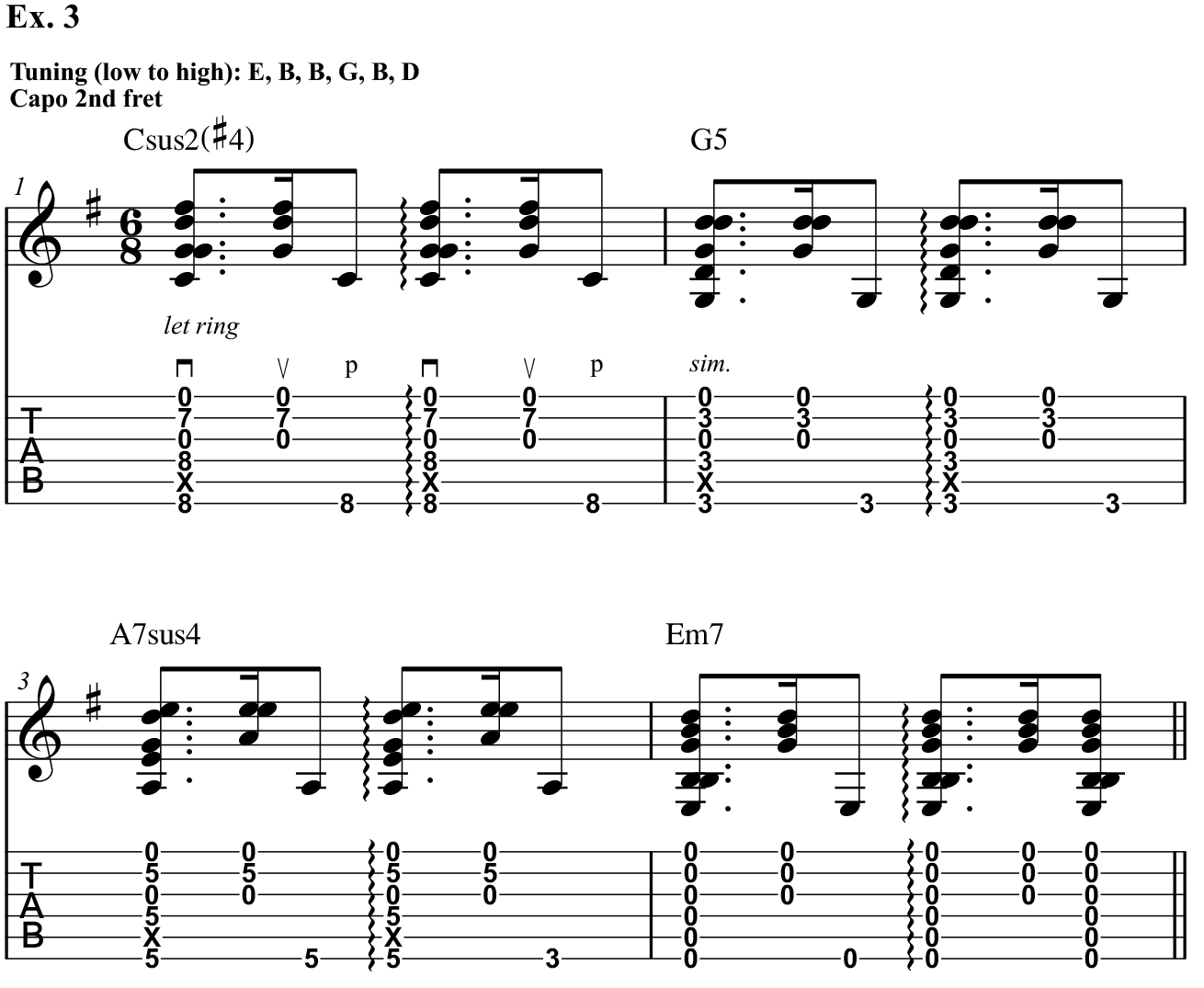
“Independence Day” from 1998’s Little Plastic Castles explores themes of love, war and the nature of relationships. Ex. 4 is along the lines of a brief interlude in the song, and features some nifty hammer-ons and finger slides. The tuning is just a minor alteration from the previous one, with the 3rd string lowered to F# and the 1st raised back to E. Ringing open strings support the low fretted notes, evoking a dreamy vibe.
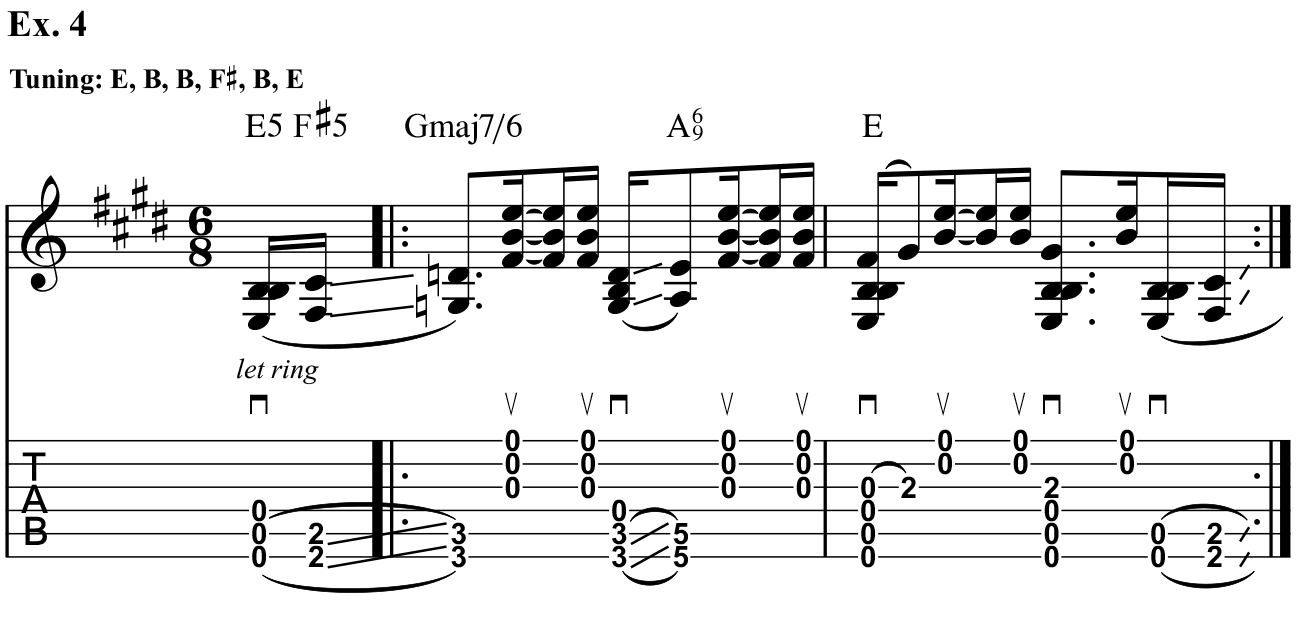
Ex. 5 is inspired by “Blood in the Boardroom,” from 1993’s Puddle Dive, in which Ani narrates the thoughts of a woman getting her period in the midst of a male-dominated business meeting. In DADGAD tuning, she forthrightly strums big power chords and sus2 voicings. Notice in the example how adding the sus2 couldn’t be more convenient, as it simply requires fretting one additional note; making this change would be awkward as part of a barre chord in standard tuning. Plus, DADGAD tuning allows for power chords comprising all six strings, sounding open and atmospheric, which is again of great advantage when playing solo.
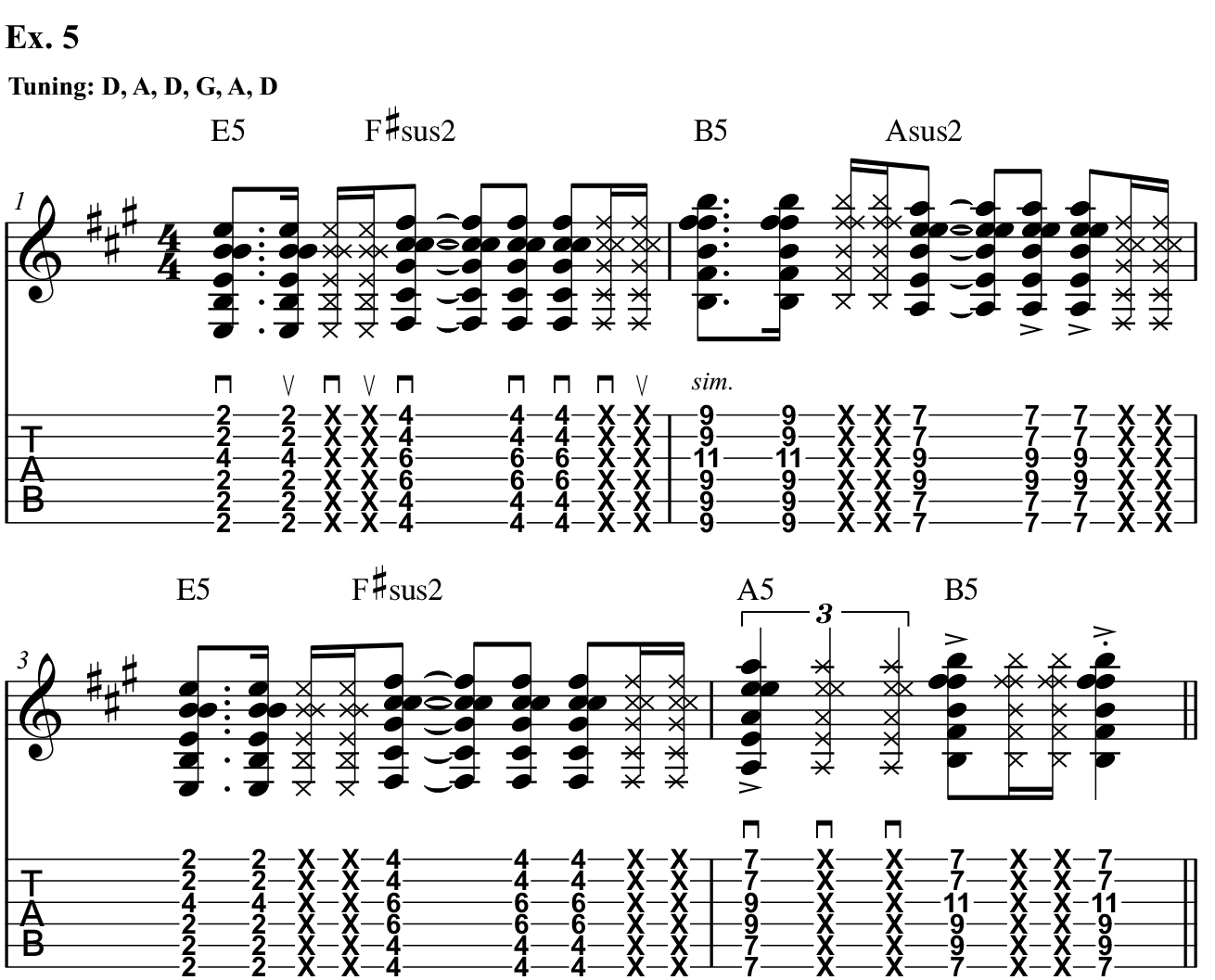
Let’s take a quick break to explore DiFranco’s gear. She mainly plays a variety of Alvarez guitars (including a baritone), but also has an assortment of others that includes an old Martin D-28. In the studio and on stage, she mic’s her guitar, mixing it with a direct signal — but there’s more: She currently achieves her variety of acoustic tones by employing two Magnatone Twilighter amplifiers from the ’60s, which are no longer made. One is set for an overdriven tone, while the other is cleaner, often with tremolo added. Ultimately, she mixes the mic’d and direct signals with the two amp tones to achieve the sound she desires.The guitarist summons some intriguing tones, an example of which can be heard in her 2017 NPR Music Tiny Desk Concert, available on YouTube.
Ex. 6 is not unlike DeFranco’s lovely intro to “Even More,” from 2017’s Binary, in which she varies DADGAD tuning ever so slightly by lowering the 1st string to C (low to high: D, A, D, G, A, C). Open-string-based hammer-ons and pull-offs sound more curiously melodic as they climb up the neck, mixing with the bass notes and an open G-string drone. The harmonics in the last bar, beautifully dissonant, offer another feature of altered tunings, as this combination of natural harmonics would be virtually impossible to play in standard.
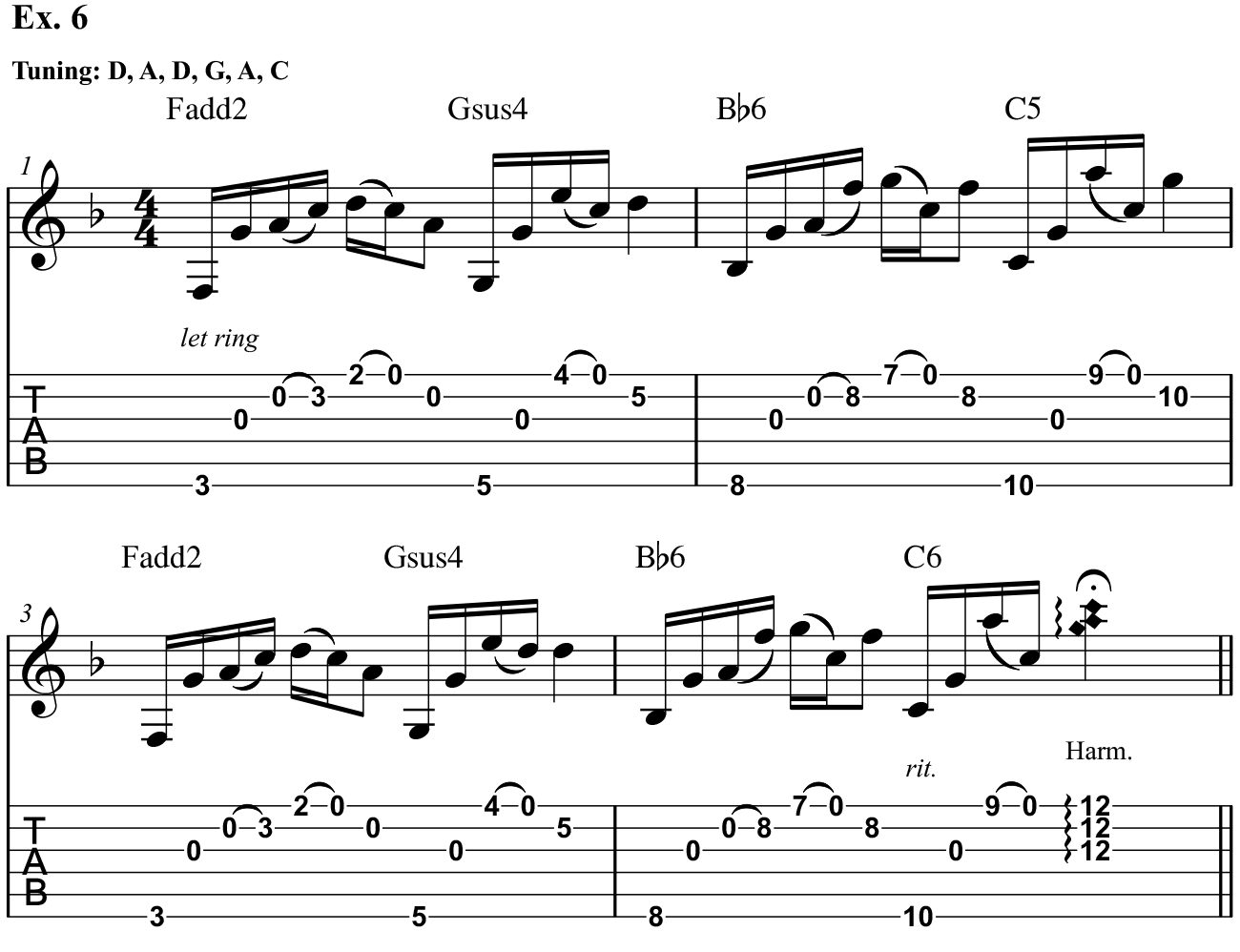
In “Two Little Girls,” from Little Plastic Castles, DiFranco tells the story of two friends who first meet as teenagers. Here, she uses a different variation of DADGAD, this time with the 4th string lowered to C (D, A, C, G, A, D), and don’t forget to tune your 1st string back up to D! The guitarist employs a variation of Carter-style picking, a type of playing named for Maybelle Carter, who introduced it as a member of the Carter Family band in the 1920s. In this style, the featured melody is played on the guitar’s lower strings with accompaniment above, instead of the usual other way around. In Ex. 7, reminiscent of the song’s intro, notice that all of the notes on the 5th string are to be fretted with your middle finger, as indicated below the tab.
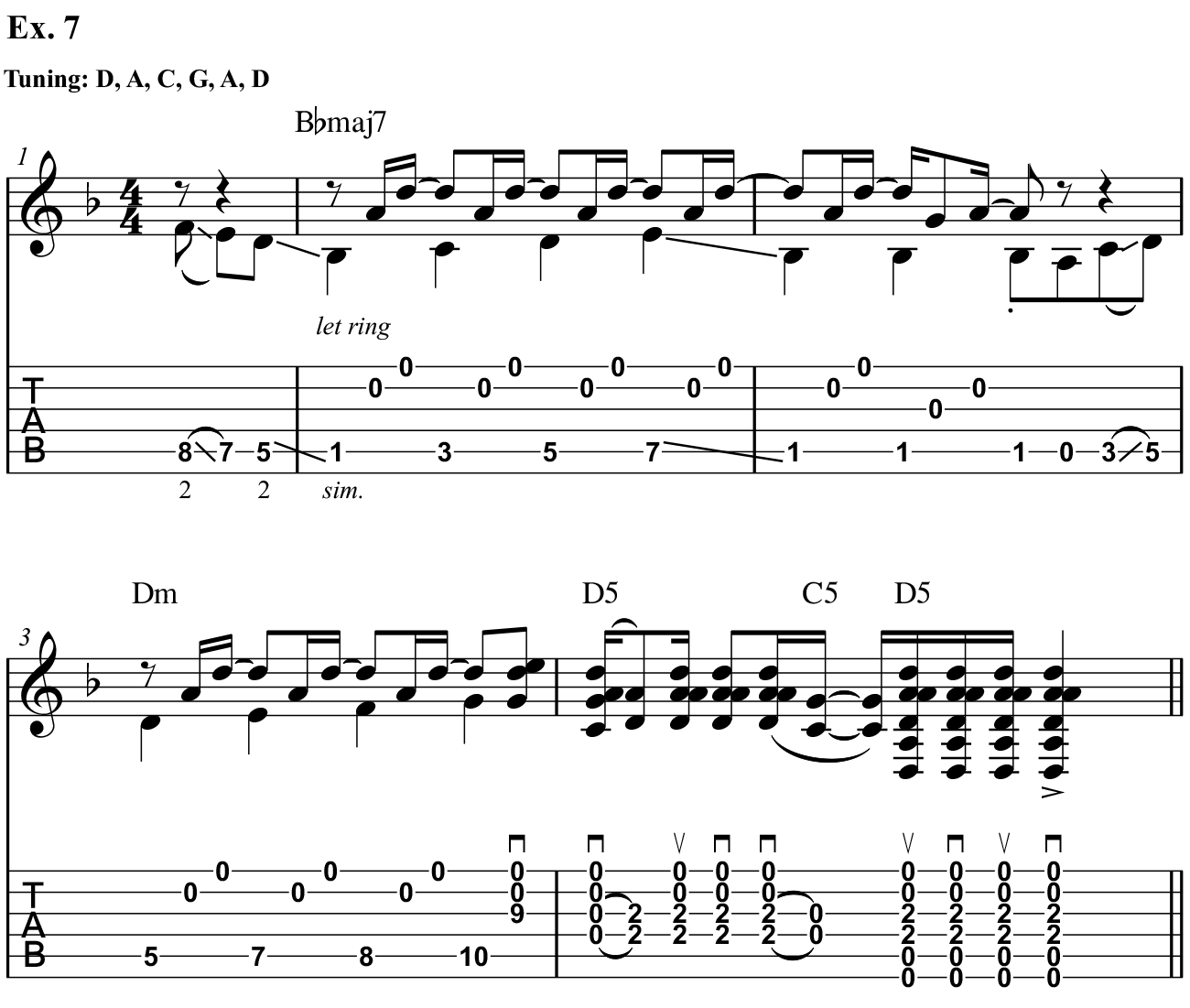
Our final destination is a lush, low tuning (C, G, C, G, C, D). The previous tuning is altered by lowering the 6th string even further to C and the 5th string to G, then tuning the 2nd string up to C. Ex. 8 is inspired by “Falling Is Like This,” from 1994’s Out of Range, a song about balancing the joy of finding new love with the poignant awareness of its possible demise. Here, DiFranco combines some of the approaches she used above; octave hammer-ons and finger slides are juxtaposed with droning open strings, plucked in a descending pattern. The overall result has an ethereal quality, evoking both hope and despair.
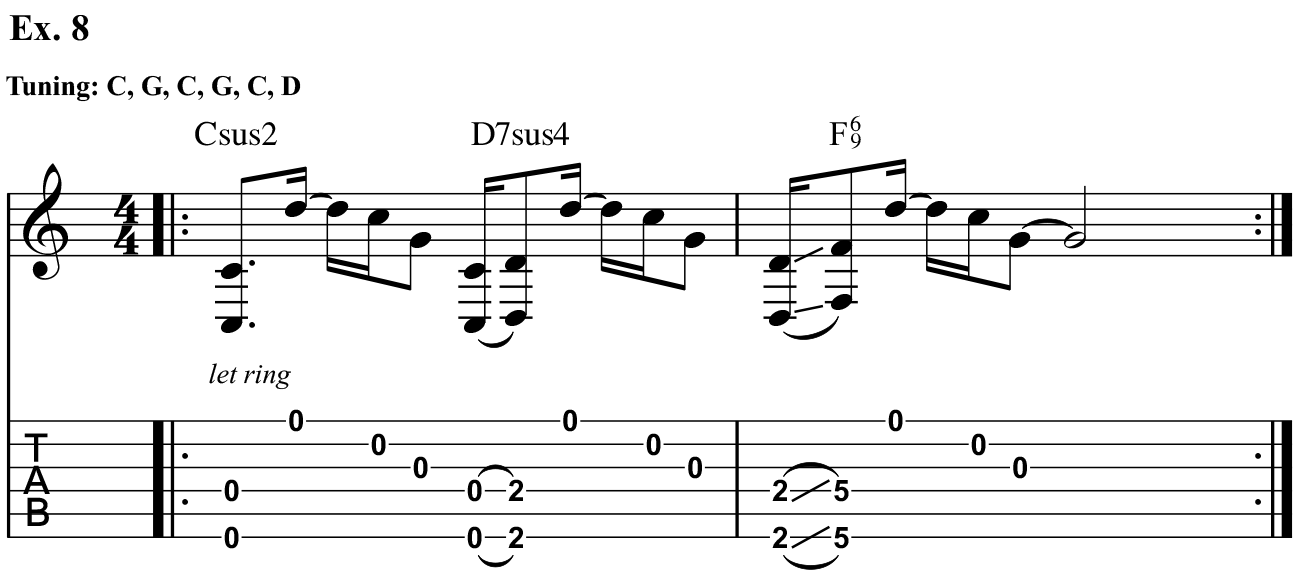
The songs DiFranco mines from her cornucopia of tunings often blossom with airy voicings, suspended chords and harmonically-nondescript but rich, colorful soundscapes; the tunings covered in this lesson are a mere introduction to the palette of colors she creatively draws upon for her emotive songwriting. DIY musicians of all sorts who have followed her owe a warm debt of gratitude to this uncommon and innovative artist.
Jeff Jacobson is a guitarist, songwriter and veteran music transcriber, with hundreds of published credits. For information on virtual guitar and songwriting lessons or custom transcriptions, reach out to Jeff on Twitter @jeffjacobsonmusic or visit jeffjacobson.net.


